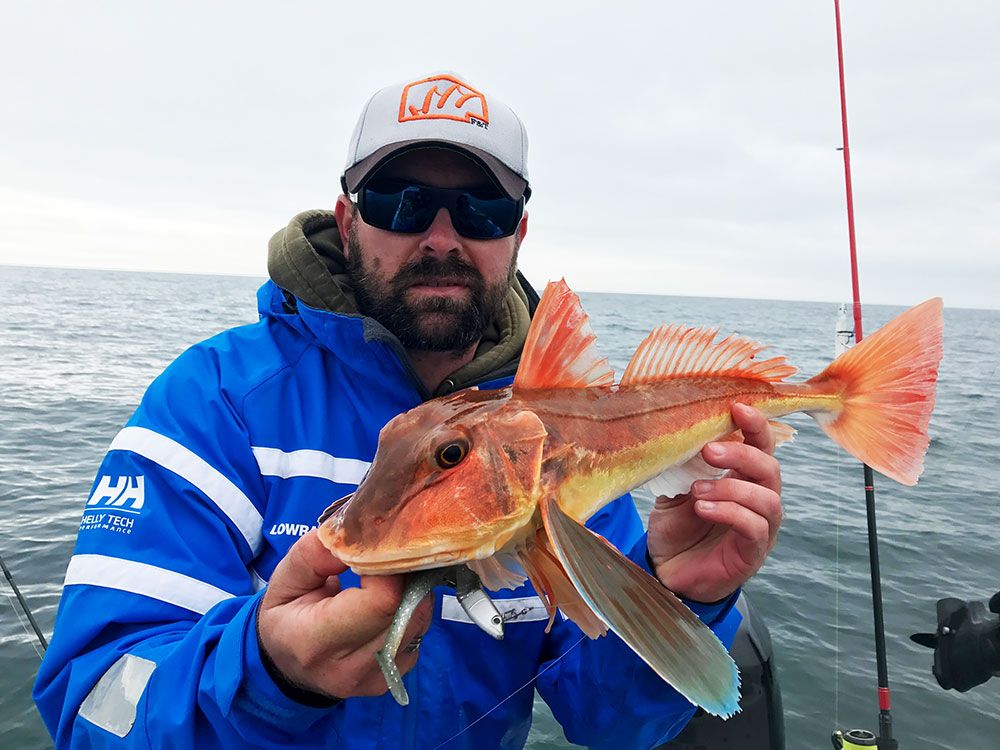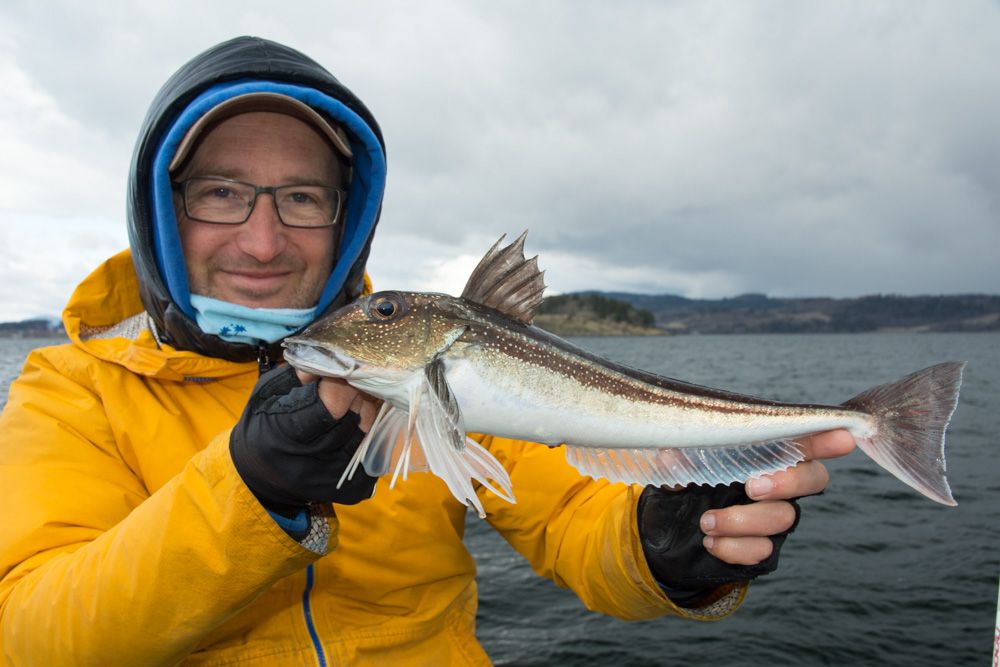There are three common types of gurnard in the UK, the tub gurnard growing to over 10lbs, the grey gurnard which can weigh up to 2.5lbs, and the red gurnard reaching a little over 3lbs. In addition, there is the rare streaked gurnard, a visitor from the Bay of Biscay and the Mediterranean, this being the smaller of the four and rarely caught over a pound.

For most anglers they are an accidental catch, but it is possible to target them to some extent, and they are one of our best looking fish, especially the brightly coloured tub, red and streaked gurnard.
Season
The best fishing for gurnards is from May right through to November, with the peak period falling from July to October. If you’re targeting the bigger fish, then late August to late October is the perfect time.
Habitat
Juvenile gurnards of a few ounces will inhabit clean sand and live in relatively shallow water close to shore, around 20 to 30-feet deep. As they reach adulthood, they are invariably found on sandy patches among reef and rocky ground in water from 100–feet to over 200-feet.
The grey, and the rarer streaked gurnard, favour a more sandy habitat feeding around rising sandbanks and areas where shell accumulates, also very broken ground where sand predominates with a light scattering of boulders. The red and the tub seek rougher ground, with both happy to feed directly over flat rocky shelves and inside deeper gutters among boulders and low rising reef ground.
Weather and Tides
The bigger offshore gurnards are not troubled too much by a period of rougher seas. In water of 100-feet or less, allow a few days after a blow for the sea to settle and the swell to subside for the best catches. They take best on days when there is some cloud cover, but you’ll still catch on the brightest days, especially in the deeper water.
Gurnards have a flat belly and are best suited to sitting on the seabed or moving along it, waiting and seeking food. They will lift off the seabed to intercept passing prey, so this tells us that the smaller to middle-sized tides are the best. On the bigger, faster flowing tides, the gurnards are less active and tend to hunker down in areas where the tide passes over them.
The smaller to middle-sized tides are also best for drift fishing as the boat drift will be slower, especially if the wind is blowing against the flow of tide, and this gives you much more time over the fish.
They feed best in the middle hours of the flooding tide, and again during the middle of the ebb tide, but catches on the flood are usually higher.

Tackle
In shallow water, fish a Tronixpro Banzai 6/12lb Boat Rod and maybe a small 6500 sized multiplier reel such as the Banzai Tournament Mono Mag or even a 4000/5000 sized fixed spool loaded with 12/15lb Tronixpro Xenon Mainline or better still, 20lb Tronixpro X8 Probraid. Add a 20lb Tronixpro Fluorocarbon leader about twice the length of the rod to minimise abrasion on the main line.
In the deeper water and on bigger tides, a Tronixpro Banzai 12/20lb Boat Rod and a multiplier reel holding 300-yards of 30lb Tronixpro X8 Probraid plus backing is needed. Again, add a Tronixpro Fluorocarbon shock leader of 30lbs.
If you like to keep things simple, choose an Axia Tinsel Feather Rig, or an Axia Luminous Hokkai Rig and bait these with a small sliver of mackerel. These work over both sand and rough ground. It pays to cut the feathers down to just three to keep the baits closer to the seabed for more bites.
For drift fishing, a better rig is a 2-hook rig with the lower hook length positioned tight behind the lead weight link. Position the second higher hook about 32-inches above the lower hook. Make the hook lengths 15-inches long and from 20lb Tronixpro Fluorocarbon. This rig sees the lower hook bait dragging across the seabed and the higher hook bait just fluttering up off the seabed a few inches.
For general sized fish, a size 2 to 1 Tronixpro Aberdeen Hook, but when targeting bigger fish, go up to a size 1/0.
You can increase catches by adding alternate red, white, or yellow 5 mm beads to the hook length to add colour to draw the fish in. Also, try sliding on one of the Tronixpro Blades followed by three coloured beads. Blades come ready for mounting on a clevis pin which slides freely on the line and allows for a totally free rotating blade that adds colour, flash, and vibration just above the bait. Red and white/silver blades work best.
Also, try adding a Tronixpro Rattle Bead to the hook length. These give off both vibration and noise as they spin on the hook length and will help attract the fish when bites are slow.
Baits
Gurnards are predatory fish feeding mainly on small prey species as well scavenging what they can find. No surprise then to see that the top bait is a fresh sliver of mackerel cut from the white belly, about 2-inches long by a half-inch wide. Pass the hook in through the skin side first, then fully back out again so that the hook sits above the skin side of the fish and not on the flesh side. Leave a good length of mackerel sliver below the hook to freely move as the bait is drawn across the seabed to imitate a small wounded fish.
A body section or small fillet/sliver of launce sandeel or bluey works well, as will fresh herring. Slivers of whiting also catch but not as consistently as the oily fish will.
Tactics
Fishing on the drift is simply a case of letting line down until you feel the lead weight bump the bottom. Now release a good 20-yards of line, then stop the spool with your thumb. Feel how the lead reacts. If it lifts up off the seabed and holds in the tide, then go up a couple of ounces higher. Do this until the lead weight just keeps in contact with the seabed. When you lift the rod tip, the weight should be light enough to bounce off downtide a few feet if you release a little line, then recontact the seabed again as you stop the spool. Getting this balance is critical to maximising catches over mixed and rough ground. Hold the spool and feel the weight drag across the bottom for say 30-seconds, then release a few feet of line to let the bait rest a few seconds. It’s this steady retrieve, then stop and start motion as you rest the bait that attracts the fish in.

Also, remember that you need to have plenty of line out to get both hooks fishing fairly tight to the seabed. Even in a light tide with a slow boat drift, having 50 to 60-yards of line out is not too much. When the boat speed is faster, fishing at 100-yards is common. The mistake is to have your main line entering the water nearly vertical. It needs to be at a shallow angle leading away from the boat to be fishing effectively.
A classic trick when fishing the mackerel feathers or Hokkai’s over rough ground when the boat drift is not too fast is to deliberately “bounce” the lead weight on the seabed by lifting and lowering the rod. You’re looking to create a rhythmical “tap, tap, tap” sound. This will draw the gurnards in and is especially effective for bigger tug gurnards.
If the water is carrying a little colour, or the day is very overcast with rain, and you’re fishing in deep water, add one or two Tronixpro 5 mm Luminous Oval Beads just above the hook. Charge these with a Tronixpro UV Torch. The beads will emit a good amount of light at depth and can help to pull the gurnards in towards the bait.
As you drift along, when you feel the rod tip pull over to a sudden weight, or feel the rattle of a fish on the rod tip, release a few feet of line to let the fish fully eat the bait. Now click the reel back into gear and let the line tighten to the fish to pull the hook home.


